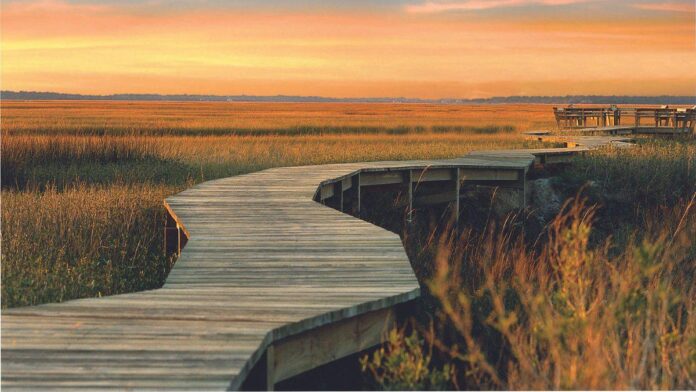The U.S. South is home to a wealth of iconic indigenous fauna ranging from the American alligator to … [+]
Visit Lake Charles
Spring is in full swing across the Northern Hemisphere, and as we welcome the warm weather and extra daylight, Earth Day is just on the horizon. Established in 1970, this annual event serves as a call to action for the preservation of our home planet, ushering in conversations around renewable energy, protecting biodiversity, reducing plastic waste, and a wealth of other sustainability-driven causes.
Though Earth Day brings environmental issues to the forefront of public discussion each April, avid ecotourists are on the lookout for pristine natural destinations 365 days a year—and the Southern United States just happens to be a treasure trove of protected parks and wildlife preserves brimming with native flora and fauna. Whether you’re hoping to kayak through untouched waterways, trek through old-growth forest, or cross a critically endangered bird off of your life list, these five Southern destinations are well worth visiting.
Amelia Island, Florida
Amelia Island is equipped with 13 miles of sandy Atlantic shoreline.
Amelia Island CVB
Planning a trip to the Sunshine State? Don’t miss out on Amelia Island, a charming seaside getaway located just northeast of Jacksonville. Down in the southernmost reaches of the island, the idyllic 200-acre Amelia Island State Park is an absolute must-visit for those seeking out native shorebirds—but there’s no need to travel far to find wildlife on the island. The city of Fernandina Beach is rife with incredible ecotourism destinations ranging from Egan’s Creek Greenway Trail—a top spot for alligator sightings—to the Fernandina coast, a sandy expanse that’s ideal for viewing bottlenose dolphins and even the occasional sea turtle. Once you’ve had your fill of wildlife viewing, beer fans can head to First Love Brewing for some much-needed hot honey pizza paired with a hoppy Cardinal Truth IPA.
The Gulf Coast, Mississippi
The Gulf Islands National Seashore is shared between Mississippi and Florida.
Coastal Mississippi
Equipped with 62 miles of shoreline alongside countless islands, Mississippi’s Gulf Coast is an oft-underrated destination that packs a serious punch within the realm of ecotourism. Just east of Biloxi, the Davis Bayou Area provides ample opportunity for spotting the state reptile of Mississippi—the American alligator—while the nearby Mississippi Sandhill Crane National Wildlife Refuge offers some much-needed protection for a wealth of indigenous species ranging from the dusky gopher frog to the Mississippi sandhill crane, a distinct subspecies that’s native to the Gulf of Mexico. For a truly memorable experience, be sure to book a private boat excursion to one of the region’s Gulf Islands, a collection of pristine isles that serve as a refuge for more than 300 different bird species including plovers, terns, and black skimmers.
Lake Charles, Louisiana
The American white pelican is a common sight in southern Louisiana.
Justin Hoffman
Louisiana is renowned across the nation for its high degree of biodiversity, and for those wishing to encounter the wide array of flora and fauna that call the state home, Lake Charles is the perfect base. This lakeside city serves as the gateway to the Creole Nature Trail, a lengthy scenic byway that spans more than 180 miles across southwestern Louisiana. Highlights along the route include Sabine National Wildlife Refuge—a 124,000-acre marsh that’s rife with alligators, river otters, and shorebirds—as well as Rockefeller Wildlife Refuge, a coastal preserve that’s renowned for its high degree of avian biodiversity. After a long day of exploring the Creole Nature Trail, visitors are welcome to head back to Lake Charles for some well-deserved boudin, an ultra-savory sausage that’s popular across the region.
Cumberland Island, Georgia
Cumberland Island has been home to wild horses for hundreds of years.
getty
Just north of the Florida-Georgia border, Cumberland Island serves as one of the Peach State’s most idyllic island getaways, with more than fifty square miles of protected land to explore. The island’s 16 miles of pristine coastline are perfect for spotting native shorebirds mingling with loggerhead sea turtles, while history buffs can discover a wealth of centuries-old structures ranging from the Dungeness Mansion Ruins to the historic First African Baptist Church. After a long day of exploring the island, be sure to head back to the mainland city of St. Marys to visit the Cumberland Island National Seashore Museum—and maybe grab a fresh Pecan Porter from local favorite Brackish Beer Company once you’re done.
Corpus Christi, Texas
Corpus Christi is home to the USS Lexington, a World War II-era aircraft carrier that’s currently … [+]
Visit Corpus Christi
While Texas is renowned for its bustling urban hubs like Houston and Austin, the seaside city of Corpus Christi is a veritable treasure trove for nature lovers visiting the Lone Star State. There’s no shortage of top-tier birding sites to visit across the area, but for newcomers, the sprawling Padre Island is an absolute must-visit. This massive barrier island consists of more than 65 miles of protected shoreline, serving as a much-needed refuge for the critically endangered Kemp’s ridley sea turtle alongside more than 380 different bird species. For nature opportunities closer to downtown, Blucher Park is a top spot for urban birding, while the Texas State Aquarium does a stellar job of highlighting the native species that call the surrounding Gulf of Mexico home.










